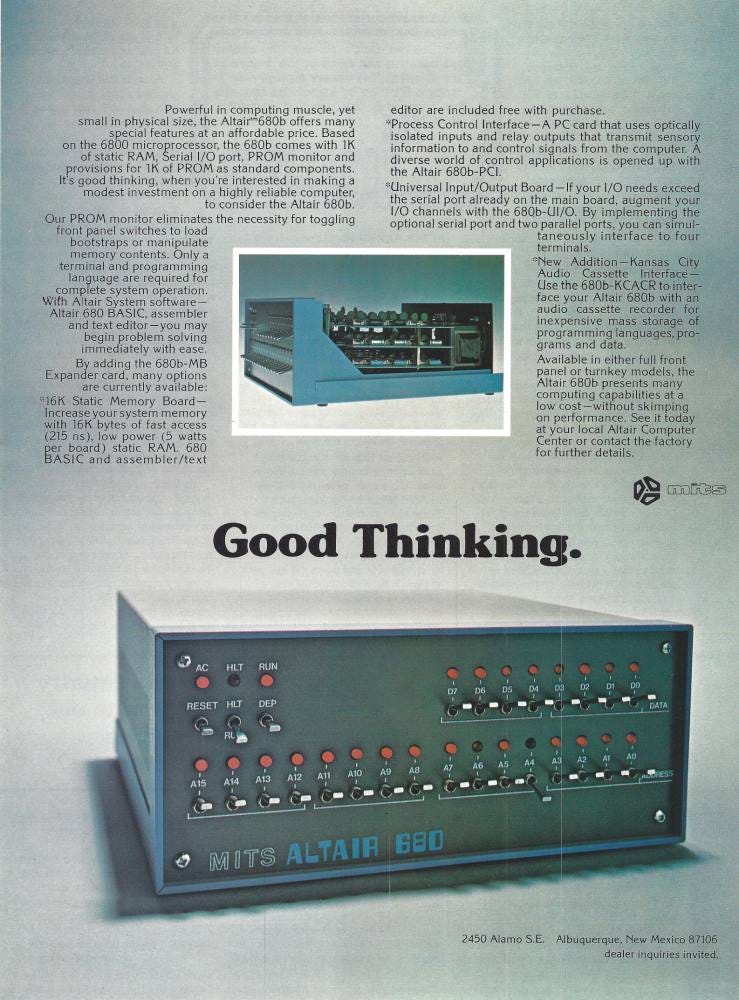The Company
Micro Instrumentation and Telemetry Systems (or commonly known as MITS) was founded in 1969 by Ed Roberts and Forrest Mims. Originally, the company produced parts for model rockets. In 1971, the company started to produce calculators. The calculators were a success and in 1973 generated one million in sales. However, a price war left the company in debt.
To rescue the company, Roberts decided to create a low-cost computer kit. The resulting system, the Altair 8800, was released in January 1975. You could either purchase a kit for $439 or the assembled version for $621. The system was powered by an Intel 8080 and had a front panel with lights and toggle switches for input and programming.
The Altair 8800 was extremely popular. It was the first time that ordinary people could buy their own computer. In the Triumph of the Nerds, a former MITS employee revealed that customers were so eager to get a hold of their own Altair that they would camp out in the MITS’ parking lot.
The success of the Altair sparked the creation of a new industry: home computing. Companies started making software and hardware for the Altair. There were even companies that released clones of the Altair, such as the IMSAI 8080. One of these companies is still around today, and you have undoubtedly used one or more of their products: Microsoft. (Before the Altair came along, the team behind Microsoft made traffic counters. Bryan Lunduke has a great article on that topic.)
Eventually, Roberts lost interest in running a computer company and wanted to become a doctor. The company was sold to Pertec Computer Corporation for $6 million in 1976. Pertec continued to sell Altair systems.
The Altair 680
MITS decided to follow up the Altair 8800 with a new model with a new chip. In October 1975, the Altair 680 was released. This model was smaller and used the Motorola 6800 chip.
The Altair 680 had a number of problems. It didn’t use the same S-100 bus as the 8800, meaning that boards created for the 8800 would not work in the 680. The front panel, since it was smaller, was missing a number of debug options that the previous model had. A YouTube historian speculated that the front panel was included because customers were used to it.
A former Pertec employee had the following to say about the Altair 680:
The Altair 680 did not sell well compared to the 8800. It found a niche market as a machine or process controller. After the iCOM acquisiton, the Turnkey model of the 680 (with reduced function front panel) was sold in the ICOM product line. As far as I know the motherboards were the same for both models.
Several MITS products died because Pertec focused on the Business Computer products. Hobbyist, engineering, and manufacturing markets faded accordingly. I'm guessing that the arrival of Phillips NA marked the end of everything "MITS" except the PCC 2000 system.
I was told that 680 BASIC is fast compared to 8080 BASIC. But the speed is of limited use without more RAM and floppy drives. The general market developed to use 8080/Z80 code, and CP/M and accounting software was hungry for RAM.
To watch an in-depth look at the MITS Altair 680, check out this YouTube playlist.
What computer ads would you like to see in the future? Please comment below. If you enjoyed, please share with your friends and relatives. Thank you.







Great post. Just a few grammar notes.
"models rockets" should probably be "model rockets"
"Atari 6800 on top of an Atari 8800" should be "Altair 680 on top of an Altair 8800"